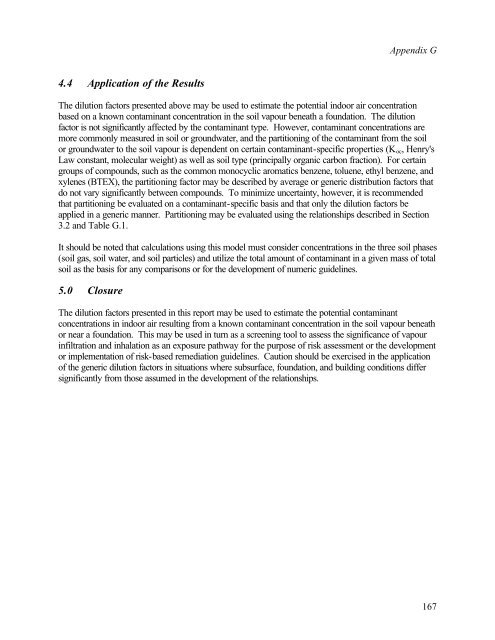Protocol for the Derivation of Environmental and Human ... - CCME
Protocol for the Derivation of Environmental and Human ... - CCME
Protocol for the Derivation of Environmental and Human ... - CCME
You also want an ePaper? Increase the reach of your titles
YUMPU automatically turns print PDFs into web optimized ePapers that Google loves.
Appendix G<br />
4.4 Application <strong>of</strong> <strong>the</strong> Results<br />
The dilution factors presented above may be used to estimate <strong>the</strong> potential indoor air concentration<br />
based on a known contaminant concentration in <strong>the</strong> soil vapour beneath a foundation. The dilution<br />
factor is not significantly affected by <strong>the</strong> contaminant type. However, contaminant concentrations are<br />
more commonly measured in soil or groundwater, <strong>and</strong> <strong>the</strong> partitioning <strong>of</strong> <strong>the</strong> contaminant from <strong>the</strong> soil<br />
or groundwater to <strong>the</strong> soil vapour is dependent on certain contaminant-specific properties (K oc , Henry's<br />
Law constant, molecular weight) as well as soil type (principally organic carbon fraction). For certain<br />
groups <strong>of</strong> compounds, such as <strong>the</strong> common monocyclic aromatics benzene, toluene, ethyl benzene, <strong>and</strong><br />
xylenes (BTEX), <strong>the</strong> partitioning factor may be described by average or generic distribution factors that<br />
do not vary significantly between compounds. To minimize uncertainty, however, it is recommended<br />
that partitioning be evaluated on a contaminant-specific basis <strong>and</strong> that only <strong>the</strong> dilution factors be<br />
applied in a generic manner. Partitioning may be evaluated using <strong>the</strong> relationships described in Section<br />
3.2 <strong>and</strong> Table G.1.<br />
It should be noted that calculations using this model must consider concentrations in <strong>the</strong> three soil phases<br />
(soil gas, soil water, <strong>and</strong> soil particles) <strong>and</strong> utilize <strong>the</strong> total amount <strong>of</strong> contaminant in a given mass <strong>of</strong> total<br />
soil as <strong>the</strong> basis <strong>for</strong> any comparisons or <strong>for</strong> <strong>the</strong> development <strong>of</strong> numeric guidelines.<br />
5.0 Closure<br />
The dilution factors presented in this report may be used to estimate <strong>the</strong> potential contaminant<br />
concentrations in indoor air resulting from a known contaminant concentration in <strong>the</strong> soil vapour beneath<br />
or near a foundation. This may be used in turn as a screening tool to assess <strong>the</strong> significance <strong>of</strong> vapour<br />
infiltration <strong>and</strong> inhalation as an exposure pathway <strong>for</strong> <strong>the</strong> purpose <strong>of</strong> risk assessment or <strong>the</strong> development<br />
or implementation <strong>of</strong> risk-based remediation guidelines. Caution should be exercised in <strong>the</strong> application<br />
<strong>of</strong> <strong>the</strong> generic dilution factors in situations where subsurface, foundation, <strong>and</strong> building conditions differ<br />
significantly from those assumed in <strong>the</strong> development <strong>of</strong> <strong>the</strong> relationships.<br />
167
















